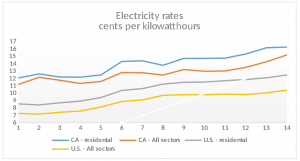California’s Renewable Portfolio Standard
California’s 2002 Renewables Portfolio Standard (RPS), Senate Bill No. 1078 mandated that electric providers procure renewable power from eligible sources at 17% of customer sales by 2017. The bill also required the Public Utility Commission (PUC), being the regulatory agency for electricity providers, establish a certification and monitoring program through the state Energy Commission. Subsequently, Senate Bill No. 107, along with executive orders, accelerated the program to require a 20% renewable procurement by the end of 2010 and 33% by the end of 2020. Recently, Governor Jerry Brown announced his proposal to further increase the portfolio standard to 50% by 2030. According to the RPS Program Overview page, California’s goal is to be, “One of the most ambitious renewable energy standards in the country”. It appears the state may have succeeded in that effort.
Currently, federal funds nurse CA’s renewables mandate in the form of subsidies like the Production Tax Credits (PTC) and American Recovery and Reinvestment Act (ARRA). However, revenue from these federal programs are not expected to continue, and pressure is mounting for the renewable fuel industry to stand on its own. In fact, several states are reconsidering their programs’ viability.
So, how will proponents peddle the program to consumers when the federal subsidies end? The full cost associated with RPS programs are difficult to evaluate. A 2015 study by the National Renewable Energy Laboratory (NREL), and prepared for the U.S. Department of Energy (DOE), estimates an expected 10% increase in electrical energy costs to consumers as a result of the state’s RPS. This, to a state with consistently the highest electricity cost in the nation. Still, the consumer impact aspect of continuing, even expanding the mandate, does not appear to be the primary consideration. The report suggests the methodologies used to discover the true costs are demonstrably inappropriate. As well, outlays for integration, transmission, and administrative expenditures are not included in the cost analysis.
NREL suggests to policymakers that going forward, they should look beyond “simply a narrow consideration” of the costs of the program to ratepayers. Instead, the report promotes the development of a means to recognize program value based on “broader societal impacts”.
